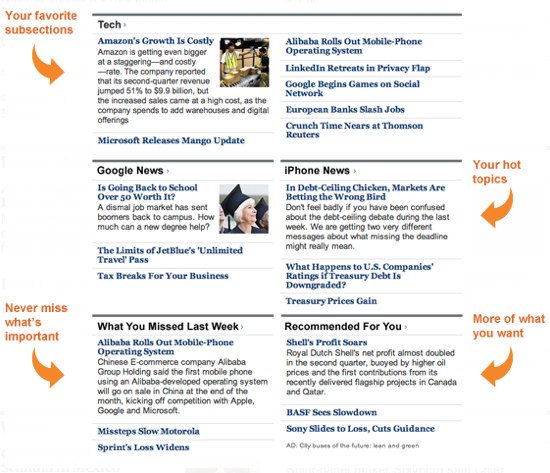
The Wall Street Journal quietly enabled a personalization feature today (or at least this is the first time I’ve noticed it). Articles are now automatically sorted based on what they think you’ll like to read. It’s powered by Los Angeles based startup Gravity.
If you’re not familiar with Gravity – it was founded in 2008 by three former MySpace executives and has gone through many iterations. Originally the company was a site where people could chat with others about topics of interest. Then they turned the engine they created to determine people’s interest graph and planned on helping other sites personalize content.
CEO Amit Kapur, formerly the COO of MySpace, wrote a guest blog post on TechCrunch last year talking about his vision around the future of personalization.
It turns out that sites want this feature. Earlier this year they began talks with the WSJ and others, and they contacted me about adding the feature to TechCrunch. We were aggressively pursuing a deal as of the day I was terminated, and I had hoped that we’d be the first to launch.
That didn’t happen apparently (and I have no idea where things stand with TechCrunch and Gravity). But I’ve been checking the WSJ site to see when it would launch there.
To see it in action go the the WSJ and scroll down to the part of the site where there’s a grid of topics with stories underneath (or just search for “personalized” and you’ll see it right away – “The sections below are personalized for you. Learn more >.”
WSJ News Personalized for You
The articles and sections in this area of WSJ.com have been selected based partly on the stories you have previously read on the site. We take your privacy seriously and while this personalization feature uses cookies, it does not connect your WSJ.com reading history to your name or other personally identifiable information.
If you prefer not to see personalized content on WSJ.com, please click here to opt out. To learn more about our privacy policy, click here. This personalization service is powered by Gravity, a WSJ.com partner. Please click here to see Gravity’s privacy policy.
There’s more here on the Gravity site about the partnership. That’s also the place where you can opt out of the service if you want to.
As you read stories on the WSJ site, and then share those stories or “like” them, Gravity is watching. Try clicking on a bunch of sports stories, for example, and you’ll see the sports section move up to the top and the top stories will be related to the things you’ve clicked on (I clicked on a bunch of NBA stories, for example).
For now it looks like the WSJ is just using Gravity in that one area of the home page. At TechCrunch we were planning on rolling it out on the site as a whole. Important stories (determined by us) would still be positioned on top. But if you only seem to read stories about Apple, there’d be a concentration of those stories, too.
Gravity is charging a fee to publishers to use the service – a quite steep fee. But the data that you get back on what individuals like is a potential gold mine. You can then use that data to hyper target ads to those people. The person who only reads Apple stories, for example, would get a lot of iPad and iPhone 4GS ads.
That combination of features – providing users with a more interesting website, and getting back a ton of interesting data about those users, made it a no brainer from my perspective.
 All this year TechCrunch and others were covering the weekly SecondMarket auctions for Facebook stock. 2.7 million shares, for example, cleared in aggregate the first five auction at prices ranging from $21.01 to $28.26 per share.
All this year TechCrunch and others were covering the weekly SecondMarket auctions for Facebook stock. 2.7 million shares, for example, cleared in aggregate the first five auction at prices ranging from $21.01 to $28.26 per share.
